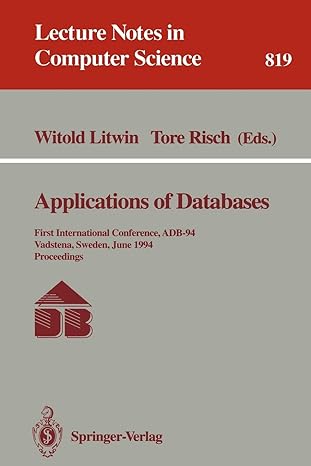Question
All in Visual Basic For this case, you will again work with the notion of bank accounts. However, this time, you will create an application
All in Visual Basic
For this case, you will again work with the notion of bank accounts. However, this time, you will create an application that will allow a bank employee to create new accounts, close accounts, and process transactions such as making deposits, withdrawals, and processing payments. In the last case, the application was simplified such that there was one customer having one checking, savings, and credit account. In this case, you must support multiple customers. Each customer can have zero, one, or many of the three account types (checking, savings, credit card).
Like any bank, all transactions must be recorded. Your application must provide a complete history of all transactions including account creation and account closing. The (teller) must be able to view all of the account history for the selected user. The transaction history should contain the transaction date, and a description at least. I suggest using a unique system assigned transaction id. How you implement this feature is up to you.
How you create the user interface is up to you. That is, you can create as many forms as you need. As you create the user interface, I do expect it to be well-designed and intuitive. All user input should validated to make sure that it's correct or at least plausible. Numeric output should be formatted to 2 decimal places. If the user makes errors, the user interface should help the user correct problems. You can use a single form or several forms.
Functional Requirements
Your solution must support the following requirements and features:
The teller must be able to create new customers and find existing customers. As in the last case, the customer should have a unique ID, last name, and first name. At the very least, you should be able to locate a customer by ID. It would be nice if you added a feature to search by last name.
Create new checking, savings, and credit card accounts for customers. Close accounts. Old accounts are not deleted. Rather, they should be closed by setting a Boolean flag. Validate the account number is an integer. All fields are required. Checking and savings accounts have a unique id, and current balance. Same as the last case.
Display account balances for a customer's various checking, savings, and credit card accounts.Again, you must provide a way for the teller to select a customer.
The teller should be able to make withdrawals and deposits from checking and savings accounts.The bank employee must be able to select the desired checking or savings account. Deposits must be positive floating-point numbers. Withdrawals must also be positive floating-point numbers. The class should throw an exception if the withdrawal amount exceeds the available balance.
Make a payment to a credit card from either a checking or savings account. The payment amount must be a positive number. Verify that sufficient funds are available.Thus, when you make a payment, the credit card balance will be reduced and either the checking or savings account balance will also be reduced. Again, make sure the teller can select a specific checking and savings account from the list.
Transfer funds between checking and savings accounts. Validate transfer amounts and sufficient funds.
View the balances of all accounts. Display the total balance of each account type. checking/savings/credit card. Tally and display the total funds available (checking + savings - credit card)
View the transaction history of all accounts.
Validate all user input and advise the user if there are any errors. Create exception handlers, as necessary.
Save all of the lists via serialization or by reading and writing sequential files. You can use either technique but you will find the code to serialize and deserialize the objects much shorter than the code to implement sequential files.
To get things going, I strongly suggest that you create some random data (3-4 customers, and 2-3 accounts for each customer. It will make the program much easier to develop and test.
Step by Step Solution
There are 3 Steps involved in it
Step: 1

Get Instant Access to Expert-Tailored Solutions
See step-by-step solutions with expert insights and AI powered tools for academic success
Step: 2

Step: 3

Ace Your Homework with AI
Get the answers you need in no time with our AI-driven, step-by-step assistance
Get Started


